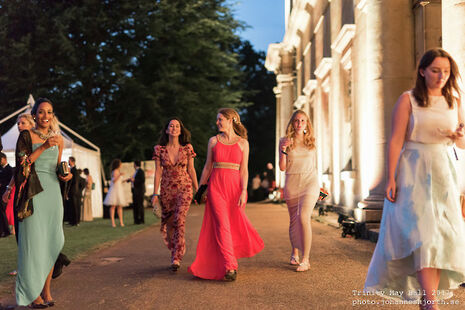Dressed to impress?
Our columnist Holly Platt-Higgins explores the pressures that come with dressing to impress in Cambridge.

I recently engaged in a rather uncomfortable conversation with my mother and my godmother, during which we stayed away from the usual safe topics of horticulture, annoying husbands and summer holiday plans and instead, boldly ventured onto Instagram (which I don’t actually think my mum understands) and began digging our teeth into ‘pressure for young women in your generation.’
Apparently, going to the gym, contouring and Hollywood waxing just wasn’t happening in the 80’s. Back then, it was all about big eyeliner, big hair, shoulder pads, mom jeans and Princess Di. While my mum and godmother were discussing how much easier it was for them, how no one would ever think twice about a fat roll and how everyone was just longing for a Flight Suit (Google them), I suddenly started to think how much less expensive this all sounded.
If all I had to buy to keep up was a should-pad jacket, a pair of jeans, a thick eyeliner pencil and a poster of Diana, I would only be about twenty-five quid down. But nowadays, because just about everything is endorsed by the Kardashians, fashions fluctuate so quickly that by the time your delivery arrives it is no longer trending and there’s already a new craze.
So, I concluded that being an ‘It Girl’ of the twenty-first century is a thousand times more expensive, more time consuming and more confusing than it ever was in our mother’s generation. But then, I started to think, personally, I manage to ignore the pressures of social media most of the time: I’ve never owned a pair of GHDs, I really don’t care about Kylie’s latest lip kit: it’s unlikely you’ll find me duct-taping my tits into a dress to get the perfect lift anytime soon.
It seemed that, social media wasn’t really the culprit for all the crap I buy, but surprisingly it was my Cambridge social calendar. At home, my friends and I just go to the pub, where you can be dressed in old jeans and broken jumpers without any questions being asked. But, as soon as I arrived in Cambridge, a pair of skinny jeans and a pullover no longer sufficed for most of my social engagements.
“The economic pressure of Cambridge traditions come in many forms, but one I hadn’t really considered until recently is the expense of tradition on a woman’s wardrobe”
The economic pressure of Cambridge traditions come in many forms, but one I hadn’t really considered until recently is the expense of tradition on a woman’s wardrobe. Most male students will make one black-tie investment at the start of their university careers and then be set for every formal, May Ball and 21st which comes their way. And yes, you might end up splashing out for a silk cravat or an attention-seeking blazer in your final year, but that doesn’t compare to the amount of money women in Cambridge can feel compelled to pour into their social calendars.
Although it is isn’t written in the university’s set of regulations that a woman can’t wear the same dress to all her May Balls or that you have to buy different clothes for formals, a set of unwritten, unspoken social laws still exist within Cambridge culture which many feel pressured to abide by.
And isn’t this an access issue we ought to be discussing? Obviously, there are an array of much larger ones. But on a fundamental level – anyone with the academic capability to be here should feel welcome, encouraged to apply, inspired by both the academic and social opportunities offered. But how do we expect to persuade young intelligent women, who can’t keep up with the economic pressure of engaging in a Cambridge social lifestyle, to feel accommodated, to feel included?
“What is necessary, is a conscious choice by us, to shift the outlook of the university social culture”
I’m not saying disband formal or sack all the May Balls, but I think what is necessary, is a conscious choice by us, to shift the outlook of the university social culture. And, to be 100% honest, girls, I’m looking at you.
Let’s face it, most men truly really do not care, in fact, do not even think notice what you’re wearing, and, if by some chance they did, they honestly would not care if you wore it again. The people who are most likely to comment on, bitch about and highlight the content of your wardrobe are other women.
Sure, it is not entirely our fault because we’ve all grown up in a society which pits women against other women and so for this reason, we’re often encouraged to be far unkinder to and about one another than is in anyway necessary. But, the only way to demolish the unequal social laws for men and women at the university is to stop holding women accountable to them. Yes, she wore that dress last year. Yes, that’s the same skirt she wore to James’ birthday formal. So, what? We need to realise that all we get out of being spiteful about other women’s appearance and outfits is the opportunity to for people to be spiteful about us.
The 80’s 'It girl' may not have been buying the same things we are now, but they were fighting the same battle, with other women, to be considered fashionable and relevant and the only way to establish that is to condemn others as unfashionable and irrelevant.
It seems that, if the porn industry can convince us to pay forty quid to literally get hair ripped out of our vaginas, I think we should be able to convince ourselves to be kinder to other women; surprisingly, it’s far less painful.
 Features / Should I stay or should I go? Cambridge students and alumni reflect on how their memories stay with them15 December 2025
Features / Should I stay or should I go? Cambridge students and alumni reflect on how their memories stay with them15 December 2025 News / SU reluctantly registers controversial women’s soc18 December 2025
News / SU reluctantly registers controversial women’s soc18 December 2025 News / Dons warn PM about Vet School closure16 December 2025
News / Dons warn PM about Vet School closure16 December 2025 News / Cambridge study finds students learn better with notes than AI13 December 2025
News / Cambridge study finds students learn better with notes than AI13 December 2025 Arts / A beginner’s guide to Ancient Greek tragedy16 December 2025
Arts / A beginner’s guide to Ancient Greek tragedy16 December 2025









